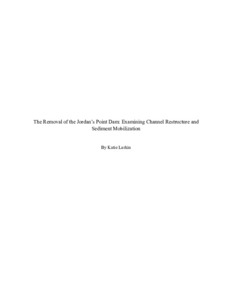| dc.rights.license | In Copyright | en_US |
| dc.creator | Larkin, Katherine Emma | |
| dc.date.accessioned | 2022-05-23T15:55:33Z | |
| dc.date.available | 2022-05-23T15:55:33Z | |
| dc.date.created | 2022 | |
| dc.identifier | WLURG38_Larkin_GEOL_2022 | |
| dc.identifier.uri | http://hdl.handle.net/11021/35865 | |
| dc.description | Thesis; [FULL-TEXT FREELY AVAILABLE FOLLOWING A 3-YEAR EMBARGO] | en_US |
| dc.description | Katherine Emma Larkin is a member of the Class of 2022 of Washington and Lee University. | en_US |
| dc.description.abstract | The 2019 removal of the Jordan's Point Dam, a low-head concrete structure built in 1911 but predated by several older crib dams, is understood to have served as a significant
geomorphological event in the Maury River. Immediate lowering of base level, channelized flow, and localized increases in water velocity have significant implications for channel restructure and sediment mobilization. The honors thesis of Chantal Iosso (2020) projected changes in sediment transport capacity and channel structure following the removal of the dam. Using repeat cross sections, channel bed armor grain size analysis, and aerial photography, the extent of channel restructure is investigated through the lens of her predictions. Moreover, comparative analysis of cross sections is used to quantify the change in channel area as well as the volume of sediment mobilized. Lastly, a geochemical analysis of riverbank legacy sediments is used to provide a brief understanding of historic productivity for the region. In its entirety, this thesis seeks to provide a well-rounded understanding of the site's geomorphological past, present, and future. The dominant channel response is observed to be degradation, with channel substrate and proximity to dam acting as slight controls. The thalweg has migrated into the center of the river and changed in profile from a sharp 'v-shape' to a gentler-sloped and wider zone of high-velocity flow, particularly in the upper reaches. Lastly, bed armor coarsening and a growing range of grain sizes found both up- and downstream of the dam supports the restoration of 'natural' conditions. Almost 3 years after the dam removal, the river continues to rework its bed and banks in order to reestablish equilibrium conditions in response to the unobstructed flow and lowered base level. | en_US |
| dc.description.statementofresponsibility | Katie Larkin | |
| dc.format.extent | 54 pages | en_US |
| dc.language.iso | en_US | en_US |
| dc.rights | This material is made available for use in research, teaching, and private study, pursuant to U.S. Copyright law. The user assumes full responsibility for any use of the materials, including but not limited to, infringement of copyright and publication rights of reproduced materials. Any materials used should be fully credited with the source. | en_US |
| dc.rights.uri | http://rightsstatements.org/vocab/InC/1.0/ | en_US |
| dc.subject.other | Washington and Lee University -- Honors in Geology | en_US |
| dc.title | The Removal of the Jordan's Point Dam: Examining Channel Restructure and Sediment Mobilization (thesis) | en_US |
| dc.type | Text | en_US |
| dcterms.isPartOf | RG38 - Student Papers | |
| dc.rights.holder | Larkin, Katherine Emma | |
| dc.subject.fast | Dams -- Environmental aspects | en_US |
| dc.subject.fast | Virginia -- Maury River | en_US |
| dc.subject.fast | Dam retirement | en_US |
| dc.subject.fast | Sedimentation and deposition -- Environmental aspects | en_US |
| local.department | Geology | en_US |
| local.scholarshiptype | Honors Thesis | en_US |
